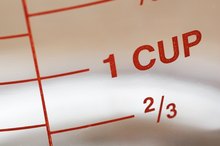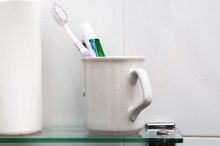How to Use Bleach to Disinfect Toothbrushes
Regularly disinfecting the toothbrushes in your home is an important part of maintaining your dental health. Disinfecting the bristles with a solution of diluted bleach kills dangerous bacteria and viruses that are present in the toothbrush, preventing them from causing an oral infection or spreading germs 1. Some common microbes that are found on toothbrushes include Mutans streptococcus, Herpes simplex and Candida albicans.
Carefully create a solution of diluted bleach in a concentration that's one part bleach to four parts water. The solution should be mixed and used in a plastic container far out of children's reach. Bleach should never be put in a metal container, as a chemical reaction will result.
How to Clean Enema Bags With Peroxide
Learn More
Place the toothbrushes head first into the diluted bleach solution. Let them soak overnight to kill any microorganisms that are living in the bristles.
Rinse the toothbrushes thoroughly in the morning and allow them to dry prior to use. The American Dental Association recommends that all toothbrushes be disinfected daily to decrease the chance of contamination.
How to Use Peroxide in My Waterpik
Learn More
Dispose of the bleach solution after each use. Once mixed with water, bleach begins to lose its disinfectant properties, so the solution must be freshly made each time the toothbrushes are cleaned.
Tips
Purchase multiple toothbrushes for each member of your family so that there is always one to use while the other is being disinfected.
If you don't like the idea of soaking your toothbrush head in a bleach solution each night, another option is to place your toothbrush in the dishwasher along with your silverware. This method of disinfection works just as well and is less time intensive than mixing a bleach solution each night.
Warnings
Use extreme caution when handling bleach, as it can be very dangerous when not used properly. When creating the diluted bleach solution, it is important to make sure the area is well ventilated, as full-strength bleach can irritate the nose, throat and lungs when inhaled.
Related Articles
References
- Is Your Toothbrush Contaminated?
- Benzoni T, Hatcher JD. Bleach Toxicity. In: StatPearls [Internet]. 2019.
- Center for Disease Control and Prevention. Cleaning and sanitizing with bleach after an emergency. Health and Safety Concerns for All Disasters. 2017.
- Centers for Disease Control and Prevention. Infection Control: Chemical disinfectants. Updated September 18, 2016.
- Centers for Disease Control and Prevention. Cleaning and Sanitizing With Bleach After an Emergency.
- E. Rhinehart, M. Friedman, and M. McGoldrick. Infection Control in Home Care and Hospice. 2006. Association for Professionals in Infection Control and Epidemiology. Jones and Bartlett Publishers.
Tips
- Purchase multiple toothbrushes for each member of your family so that there is always one to use while the other is being disinfected.
- If you don't like the idea of soaking your toothbrush head in a bleach solution each night, another option is to place your toothbrush in the dishwasher along with your silverware. This method of disinfection works just as well and is less time intensive than mixing a bleach solution each night.
Warnings
- Use extreme caution when handling bleach, as it can be very dangerous when not used properly. When creating the diluted bleach solution, it is important to make sure the area is well ventilated, as full-strength bleach can irritate the nose, throat and lungs when inhaled.
Writer Bio
Lynn Burbeck is a professional writer with over five years of experience writing for the Web. She has published numerous articles for print and online media including "Grit" Magazine. Burbeck holds a B.A. in journalism and political science.








